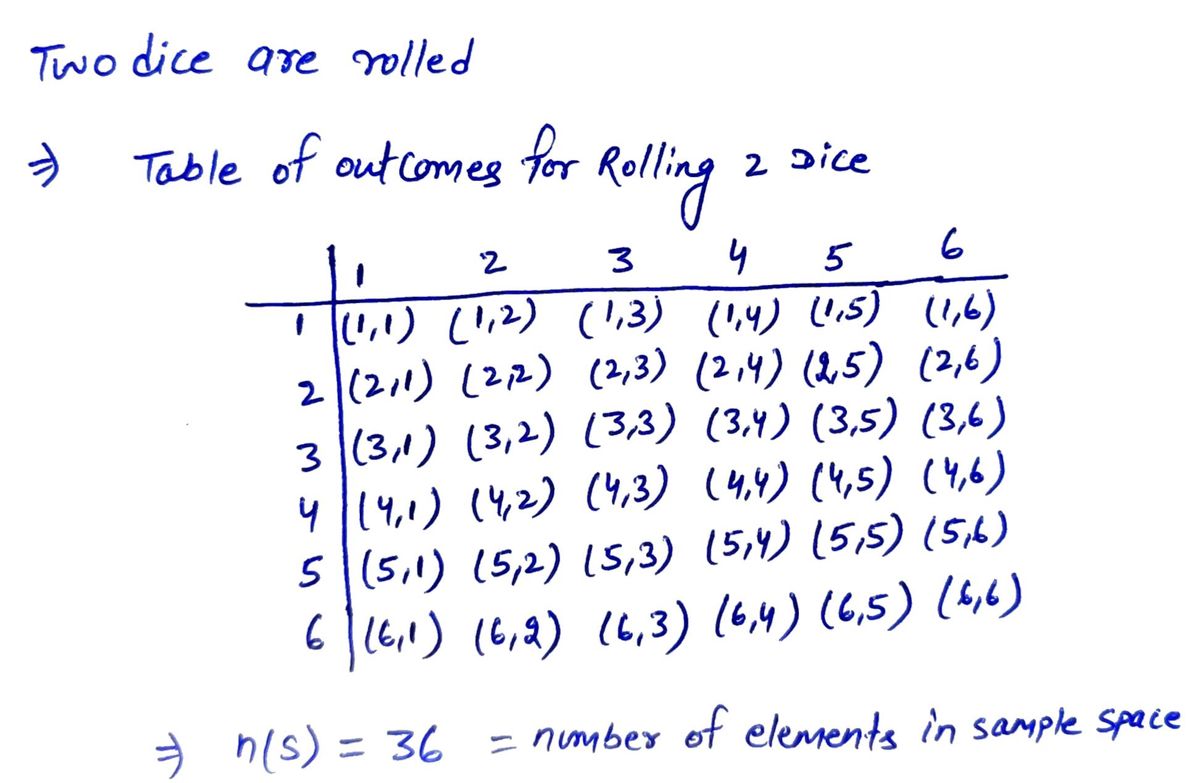2. Two dice are rolled. Find the probabilities of the following as reduced fractions and justify. Use the formula sheet to help you out. a. Are the events "first die is even" and "sum = 10" independent?
2. Two dice are rolled. Find the probabilities of the following as reduced fractions and justify. Use the formula sheet to help you out. a. Are the events "first die is even" and "sum = 10" independent?
A First Course in Probability (10th Edition)
10th Edition
ISBN:9780134753119
Author:Sheldon Ross
Publisher:Sheldon Ross
Chapter1: Combinatorial Analysis
Section: Chapter Questions
Problem 1.1P: a. How many different 7-place license plates are possible if the first 2 places are for letters and...
Related questions
Question
2. Two dice are rolled. Find the probabilities of the following as reduced fractions and justify. Use the formula sheet to help you out.
a. Are the

Transcribed Image Text:Basic Probability Principle
P(E) = n(s)
Product Rule
P(EnF) = P(E) · P(FE) = P(F) · P(E|F)
Union Rule
For sets: n(AUB) = n(A) + n(B) - n(ANB)
For probability: P(EUF) = P(E) + P(F) − P(E^F)
Complement Rule (Probability)
P(E') = 1 - P(E)
P(E) = 1 - P(E')
Complement Rule (Number of Outcomes)
n(E) = n(S) - n(E')
n(E') = n(S) — n(E)
Permutations
P(n, k)
Bayes' Theorem
P(F;).P(E|F;)
P(F;|E) = P(F1).P(E|F1) + P(F2)·P(E|F2) + ... + P(Fn)·P(E|Fn)
P(F).P(EF)
Special Case: P(F|E) = P(F).P(E|F)+P(F').P(E\F')
n!
(n-k)!
Conditional Probability
n(EnF) P(ENF)
P(F)
n(F)
Distinguishable Permutations
n!
n₁!n₂!...nk!
P(E|F) =
=
Expected Value
E(x) = x₁p₁ + x2P2 +
·+XnPn
Binomial Probability
P(k successes in n trials) = C(n. k)p(1-p)"-h
...
Combinations
C(n, k) = k!(n-k)!
Expected # of Successes of a Binomial
or Combination-based Random Variable
E(x) = np
=
2
Odds
Odds in favor of E=
If odds in favor of E are m:n,
then P(E)
m
m+n
Number of subsets
If a set has n elements,
then it has 2" subsets.
=
P(E)
P(E')
Independent Events
P(E|F) = P(E)
P(F|E) = P(F)
P(EnF) = P(E). P(F)
Table of Outcomes for Rolling 2 Dice
1
2
3
6
4 5
1|(1,1) (1,2) (1,3) (1,4) (1,5) (1,6)
2 (2,1) (2,2) (2,3) (2,4) (2,5) (2,6)
3 (3,1) (3,2) (3,3) (3,4) (3,5) (3,6)
4 (4,1) (4,2) (4,3) (4,4) (4,5) (4,6)
5 (5,1) (5,2) (5.3) (5,4) (5,5) (5,6)
6(6,1) (6,2) (6,3) (6,4) (6,5) (6,6)
Table of Sums when Rolling 2 Dice
2 3 4 5 6
5 6
6 7 8
1
1 2 3 4
2
3 4
5
3 4 5
6
7 8 9
4 5 6
7
8 9 10
5 6 7
8
9 10 11
6 7 8
9 10 11 12
Irod
Expert Solution
Step 1

Step by step
Solved in 2 steps with 2 images

Recommended textbooks for you

A First Course in Probability (10th Edition)
Probability
ISBN:
9780134753119
Author:
Sheldon Ross
Publisher:
PEARSON


A First Course in Probability (10th Edition)
Probability
ISBN:
9780134753119
Author:
Sheldon Ross
Publisher:
PEARSON
